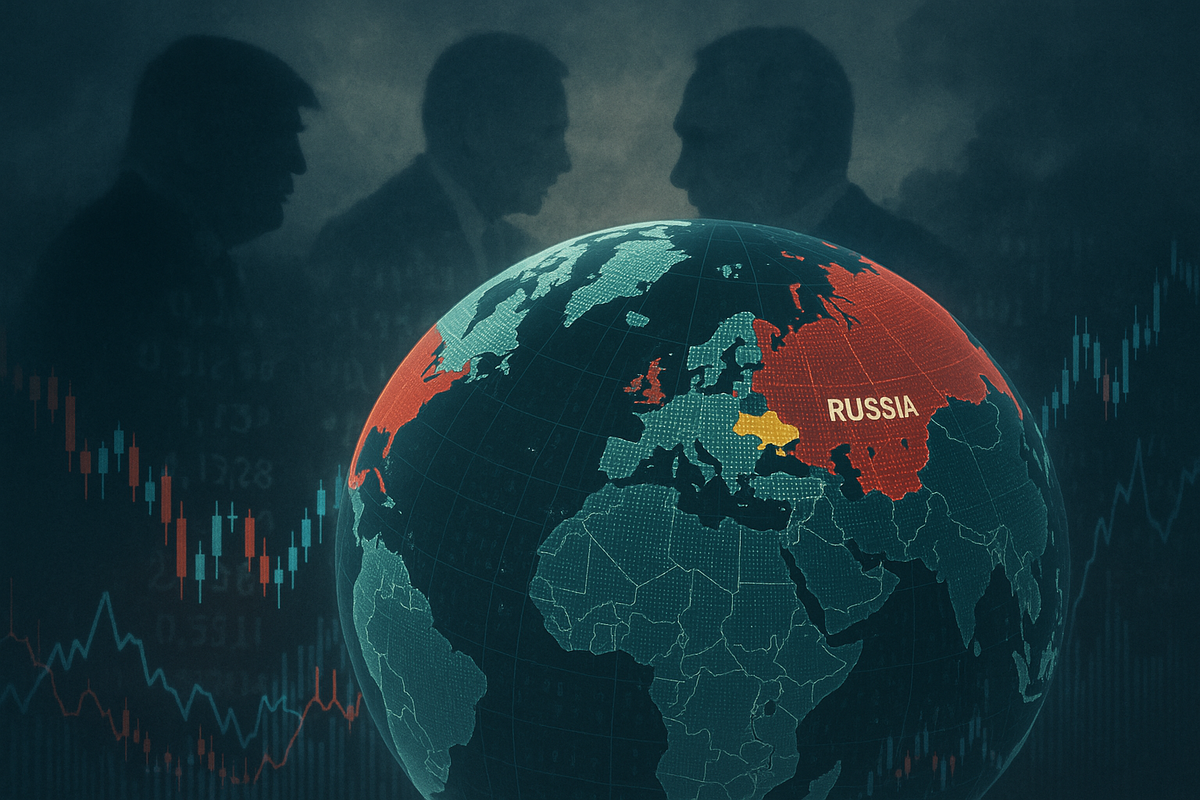
In an increasingly interconnected world, geopolitical events serve as powerful, often unpredictable, catalysts for shifts in global financial markets. From armed conflicts and elections to trade disputes and high-level diplomatic engagements, these occurrences inject a significant degree of uncertainty, directly influencing market stability and investor confidence. While the long-term trajectory of markets often remains resilient, the immediate aftermath of such events frequently sees sharp declines and heightened volatility as investors grapple with potential economic and political fallout.
A prime example of this dynamic is observed in high-stakes talks between global leaders, such as those between U.S. President Donald Trump and Russian President Vladimir Putin. These summits, even before their outcomes are known, can send ripples through financial systems. Markets react with caution and are often poised for volatility, as investors anticipate how potential policy shifts, sanctions, or agreements might impact key sectors like energy, defense, and finance. The very tone of discussions or a perceived misstep can significantly sway investor sentiment, leading to a demand for higher risk premiums and a flight to perceived safe-haven assets. A successful dialogue might reduce the "geopolitical risk premium," fostering stability, whereas a breakdown could exacerbate tensions, amplifying inflationary pressures and disrupting trade flows, underscoring the profound influence of leader-to-leader diplomacy on the intricate web of global finance.
High-Stakes Diplomacy in Alaska: A Test for Global Stability
The financial world is holding its breath as U.S. President Donald Trump and Russian President Vladimir Putin convene in Alaska today, August 15, 2025. This highly anticipated summit, set against the grim backdrop of a three-year war in Ukraine, is sending palpable ripples through global markets. Investors, analysts, and policymakers alike are scrutinizing every development, acutely aware that the outcome could significantly reshape geopolitical landscapes and, by extension, the stability of the global economy.
The primary objective of this meeting is to establish a framework for ending hostilities in Ukraine, potentially involving a ceasefire and a peace deal that could include territorial swaps. Beyond Ukraine, the leaders are expected to delve into broader issues of global stability, nuclear arms control, the volatile situation in the Middle East, Iran, trade relations, and the intricate web of international sanctions. The choice of Alaska, a U.S. military base, for this summit is seen by some as a strategic move to minimize protests and underscore a deliberate distancing from European and Ukrainian concerns, signaling a direct, bilateral approach to a deeply entrenched conflict.
This summit follows a series of high-profile interactions between Trump and Putin during Trump's first term. Their first face-to-face meeting at the G20 Summit in Hamburg, Germany, in July 2017, extended beyond its scheduled time, touching upon alleged Russian election interference, the Syrian conflict, and cybersecurity. While both leaders described the conversation as "constructive," the differing accounts on election interference created immediate political confusion. The subsequent Helsinki Summit in July 2018, the first standalone meeting, proved even more controversial. Trump's public questioning of his own intelligence agencies' findings on Russian meddling, seemingly accepting Putin's denials, sparked widespread outrage in the U.S. political spectrum. Most recently, a brief interaction at the G20 Summit in Osaka, Japan, in June 2019, saw Trump lightheartedly tell Putin, "Don't meddle in the election," a moment that underscored the ongoing political complexities surrounding their relationship.
Leading up to the current Alaska summit, the groundwork was laid through talks between U.S. Special Envoy Steve Witkoff and Putin. Notably, President Trump had recently adopted a more hawkish stance, issuing warnings of "severe consequences" for Russia if a ceasefire wasn't agreed upon and imposing tariffs on India for its purchase of Russian oil – moves interpreted by some analysts as strategic leverage. Global stocks, as measured by the MSCI All Country World Index, were trading near record highs, with Wall Street futures showing slight gains, yet investors were "tempering expectations" for a significant breakthrough. European markets continued to carry a "small degree of risk premium" due to the ongoing war, with any resolution anticipated to alleviate this. Ukraine's bonds, which initially rallied on news of the summit, subsequently stalled, reflecting the market's cautious optimism. The pre-meeting sentiment among investors and analysts was largely one of tempered expectations, with many believing the market was pricing in a "symbolic truce" rather than a "game-changer," highlighting the deep-seated skepticism surrounding the potential for substantive progress given the entrenched positions of both parties.
Corporate Fortunes Hang in the Balance: Winners and Losers in a Shifting Geopolitical Landscape
The ongoing geopolitical shifts, particularly those stemming from the conflict in Ukraine and the evolving U.S.-Russia relations, are creating a clear dichotomy of fortunes for public companies across various sectors. The outcome of the Trump-Putin summit in Alaska could significantly impact stock performance, revenue, and strategic outlook for firms in defense, energy, finance, and technology.
In a scenario of de-escalation of the conflict in Ukraine or a significant normalization of U.S.-Russia relations, the defense sector would likely experience a cooling period. Major U.S. defense contractors such as Lockheed Martin (NYSE: LMT), Raytheon (NYSE: RTX), General Dynamics (NYSE: GD), and Boeing (NYSE: BA), which have seen increased demand and robust stock performance due to heightened global tensions and increased defense spending, could face reduced demand as the perceived threat diminishes. Similarly, European defense companies like Airbus (EPA: AIR) and Leonardo (BIT: LDO), despite recent commitments to increased defense spending, might see a re-evaluation of these pledges. Palantir Technologies (NYSE: PLTR), heavily reliant on government contracts and benefiting from geopolitical instability, could also see reduced demand for its data analytics software.
Conversely, a de-escalation would likely pose challenges for U.S. shale and LNG producers, including Occidental Petroleum (NYSE: OXY), as a normalization of U.S.-Russia relations could trigger a surge in Russian oil and gas exports, potentially driving crude prices down. This would negatively impact American energy stocks. However, Russian state energy firms like Gazprom (MCX: GZPR) and Rosneft (MCX: ROSN) would be significant winners, as a lifting or loosening of sanctions would substantially boost their profitability and export capabilities. European firms with historical Russian exposure could also see a reversal of previous outflows, leading to improved performance. In the finance sector, global financial institutions would benefit from increased market stability, while Russian financial institutions, severely impacted by sanctions, would receive a substantial boost, allowing them to re-engage with the global financial system.
Should the conflict escalate or U.S.-Russia relations worsen, the defense sector would undoubtedly be the primary beneficiary. Companies like Lockheed Martin (NYSE: LMT), Raytheon (NYSE: RTX), General Dynamics (NYSE: GD), and Boeing (NYSE: BA) would see continued strong demand and stock performance as defense spending, particularly in Europe and the U.S., continues to surge. European defense companies such as Airbus (EPA: AIR) and Leonardo (BIT: LDO) would also benefit from solidified commitments to increased defense budgets. In the energy sector, U.S. energy stocks, including those represented by the iShares U.S. Oil & Gas Exploration & Production ETF (NYSEARCA: IEO) and Occidental Petroleum (NYSE: OXY), would likely see prices rise due to increased tensions and the risk of secondary sanctions. Renewable energy stocks like First Solar (NASDAQ: FSLR) and Enphase Energy (NASDAQ: ENPH) could also see accelerated adoption as countries seek energy independence.
However, an escalation would be detrimental to global stock markets as a whole, leading to increased volatility. Russian financial institutions would face intensified sanctions, further isolating them from the global financial system. Emerging markets, despite some benefiting from discounted Russian oil, could face risks from U.S. trade retaliation. In the technology sector, while cybersecurity companies would see increased demand, Western tech companies with Russian operations would likely face continued restrictions, and Russian tech companies would struggle with access to vital Western components. The intertwined nature of these geopolitical and market dynamics necessitates agility and diversification for investors navigating this complex landscape.
A New World Order: Industry Impact and Broader Implications
The geopolitical landscape has undergone significant transformations, profoundly shaped by the ongoing Ukraine conflict and, to a lesser extent, the historical context of events like the Trump-Putin summit. These events have far-reaching implications for global industry trends, impacting competitors and partners, influencing regulatory frameworks, drawing parallels with historical precedents, and accelerating the shift towards a multipolar world order, with notable effects on international trade, energy security, and alliances.
The Ukraine conflict has fundamentally reshaped international relationships. It has significantly weakened ties between Europe and Russia, and to a lesser extent, between Europe and China, while simultaneously strengthening the relationships between the United States and its European allies. This has led to increased incentives for Russia and China to undermine the transatlantic alliance. The European Union's economy has faced substantial challenges, including a sharp rise in inflation, reduced economic growth, and an increased risk of poverty for households due to soaring energy and food prices. Industries such as transport, chemicals and pharmaceuticals, and food and agriculture have been particularly hard hit. Conversely, the war has deepened the strategic alignment between China and Russia, with China providing crucial economic, political, and diplomatic support to the Kremlin, which is seen as indispensable given Western pressure. This partnership, while not a full military alliance, challenges traditional Western assumptions about authoritarian cooperation and offers an alternative model for non-democratic states.
Governments worldwide have responded with significant policy shifts aimed at enhancing national security and economic resilience. Unprecedented sanctions against Russia have been imposed by NATO allies and other countries, causing significant disruption to the global economy. These sanctions, coupled with the conflict, have led to export controls on advanced technologies, potentially dividing the world into distinct digital technology blocs. The war has also reinforced the lesson from the pandemic that supply chain resilience and self-sufficiency in strategic sectors are critical for national security. This has accelerated a trend towards on-shoring, near-shoring, and localized sourcing strategies, particularly for energy, food, and semiconductors. Europe, in particular, has undertaken a drastic re-evaluation of its energy strategy, with the European Commission's REPowerEU Plan aiming to phase out Russian fossil fuel imports by diversifying energy supplies, reducing demand, and accelerating the production of clean energy.
The Russia-Ukraine war is considered the most extensive and destructive European conflict since World War II, with the profound rift between the Russian government and the West reminiscent of the Cold War era. This conflict has significantly accelerated the world's transition towards a multipolar world order, a process that was already underway. This emerging order is characterized by fluidity, competition, and unpredictability, with overlapping ambitions and conflicting alliances. The deepening Sino-Russian cooperation, forged by the war, represents a fundamental challenge to the post-Cold War international order and the democratic response to it. The conflict and subsequent sanctions have also intensified the long-term trend of de-dollarization, with countries seeking alternatives to the US dollar for trade and reserve currencies. Global trade has been severely disrupted, leading to increased logistics costs, longer lead times, and shortages of raw materials, particularly in commodity markets and food supplies. The conflict has also triggered an unprecedented energy crisis, especially for Europe, due to Russia's weaponization of gas supplies, forcing a rapid acceleration of the energy transition towards renewable sources and diversification of energy partnerships.
The Road Ahead: Navigating Uncertainty and Seizing Opportunities
The Trump-Putin summit in Alaska represents a critical inflection point, with its outcome poised to shape short-term market dynamics and long-term geopolitical trajectories. The possibilities range from a transformative peace deal to a complete diplomatic breakdown, each scenario demanding distinct strategic pivots from businesses and governments alike.
In the event of a successful peace deal, particularly one that includes a ceasefire or a clear path to peace in Ukraine, immediate market euphoria would be expected, especially in Russian and European equities. Oil prices could stabilize or even drop by $5-$10 per barrel due to the potential surge in Russian oil and gas exports, easing global supply constraints. This de-escalation of tensions would foster a broader "risk-on" sentiment, potentially leading to sanctions relief and restoring Russia's access to Western technology and markets. In the long term, businesses would re-evaluate supply chains, potentially diversifying away from current arrangements that bypass sanctioned entities, and new investment opportunities could emerge in previously restricted regions. Governments would adjust foreign policy, potentially reducing defense spending and refocusing strategic priorities. Emerging markets like India and Turkey, which have maintained trade ties with Russia, stand to benefit from increased investment flows and normalized trade. The energy sector would see stabilization or slight lowering of global oil prices, while defense stocks, which have thrived on tensions, could experience declines.
Conversely, a complete failure of the summit, or a perceived legitimization of Russian aggression, would lead to heightened tensions and negative consequences. Short-term market reactions would be characterized by increased volatility and risk aversion, with oil prices potentially surging above $80 per barrel. This scenario would likely trigger new, tougher sanctions, including secondary tariffs on countries trading with Russia, causing widespread economic pain and retaliation. In the long term, businesses would focus on de-risking from affected regions, strengthening supply chain resilience, and potentially seeking opportunities in defense and cybersecurity. Governments would strengthen alliances, increase defense spending, and focus on national security. Emerging markets, particularly those in Eastern Europe, could face sharper declines due to energy price shocks and trade disruptions. The defense sector would continue to thrive on sustained geopolitical tensions, with increased budgets and demand for advanced military technologies, while Russia's efforts to technologically isolate itself from the West would likely intensify.
A partial agreement would likely involve limited concessions or a de-escalation in specific areas, leaving other points of contention unresolved. This would result in mixed market reactions with cautious optimism and continued uncertainty, and volatility would likely persist. In the long term, businesses would likely maintain diversified strategies, hedging against ongoing geopolitical risks while exploring niche opportunities arising from limited cooperation. Governments would seek limited cooperation on specific issues while maintaining vigilance and existing alliances. The geopolitical risk premium would likely remain, and the impact on industries would be mixed, with some sectors seeing minor improvements and others remaining under pressure. The energy sector would remain sensitive to policy shifts. Ultimately, the Trump-Putin summit represents a critical juncture, and businesses and governments must remain agile, focusing on resilience and diversification to navigate the continued uncertainty and capitalize on emerging opportunities.
Conclusion: A Defining Moment for Global Markets
The Trump-Putin summit in Alaska stands as a defining moment for global financial markets and the broader geopolitical landscape. The intricate dance of diplomacy, set against the backdrop of the protracted conflict in Ukraine, underscores the profound interconnectedness of political decisions and economic stability. The key takeaway from this event, regardless of its immediate outcome, is the undeniable influence of high-stakes geopolitical interactions on investor sentiment, commodity prices, and the strategic direction of industries worldwide.
Moving forward, investors should remain acutely aware of the "geopolitical risk premium" that continues to permeate markets. While a successful resolution in Ukraine could usher in a period of reduced volatility and new investment opportunities, particularly in energy and emerging markets, a failure could exacerbate existing tensions, leading to increased market volatility, trade disruptions, and a more fragmented global environment. The long-term implications of this summit will likely be measured not just in immediate market reactions, but in the subtle shifts in global alliances, trade patterns, and the ongoing re-evaluation of supply chain vulnerabilities.
What investors should watch for in the coming months includes the concrete implementation of any agreements reached, the response of key international players like the European Union and China, and any subsequent shifts in sanctions regimes. The resilience of global supply chains, the trajectory of energy prices, and the continued evolution of defense spending will also be critical indicators. Ultimately, the Alaska summit serves as a stark reminder that in an increasingly multipolar world, geopolitical events are not merely headlines but fundamental drivers of economic fortune, demanding constant vigilance and strategic adaptation from all market participants.





